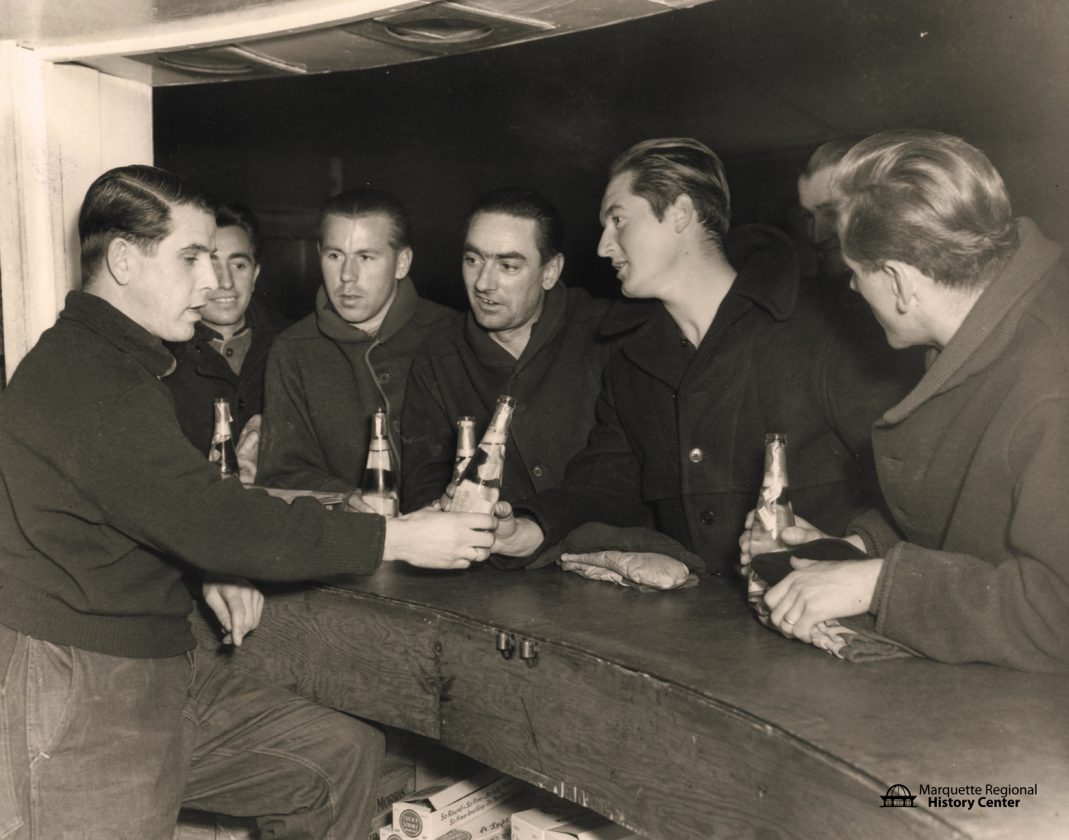Camp Sidnaw: German POWs in the U.P.

German POWs soon realized they were lucky to be in the U.P. This February 1944 picture of German prisoners at Camp Evelyn near Wetmore relaxing with beers at the camp canteen reflects conditions at the POW camps in the U.P. in general. (Photo courtesy of Marquette Regional History Center)
More than 370,000 German prisoners of war were housed in the United States in the final years of World War II. Approximately 1,100 were kept in five remote camps in the Upper Peninsula, near Au Train, Mass, Raco, Sidnaw, and Wetmore. German POWs supplied manpower for the local lumber industry. Prisoners were treated according to the Geneva Convention of 1929, and received food and pay equivalent to what American civilian loggers would earn.
When Nazi POWs first got to Camp Sidnaw in the winter of 1944, they were confused about being sent to such a remote place and felt hostility toward their American guards. In one early incident, prisoners slashed tires and broke tools to sabotage a logging expedition. The guards made them walk 12 miles back to camp in a snowstorm. Attitudes improved the next morning.
Over time, close and lasting bonds of friendship developed among German prisoners and American guards. Former enemies came to recognize that beyond national differences, they shared a common bond of humanity and interest in peaceful cooperation. Most of the German prisoners were conscripts and had no deep ideological investment in the Nazi movement. The prisoners were glad to be away from the fighting, safe though captive in a foreign country.
Camp Sidnaw, a former Civilian Conservation Corps work camp, became home to around 250 German prisoners. Red Cross inspectors noted the camp was clean and orderly. Barracks had electricity. Prisoners were issued warm blankets and had access to showers. Prisoners also received excellent medical treatment. All agreed that although they were expected to work hard, prisoners were physically comfortable, and that Camp Sidnaw was a well-organized facility.
Small gifts from local people made the POWs realize they were lucky to be in the U.P. A local farmer brought the German men fresh vegetables. A neighbor gave the prisoners fishing lures. German prisoners received musical instruments through a YMCA program and put together a lively camp band. German conscripts with experience as teachers organized classes in German and English. Prisoners were permitted to play games and sports and Camp Sidnaw prisoners organized friendly track competitions, complete with medals for winners.
The German men eventually came to take great pride in the quality of their logging work. In compliance with the Geneva Convention, prisoners were not expected to do dangerous logging work most likely to lead to serious bodily harm. A camp medic accompanied them into the woods to assist in case of injuries.
In time, Camp Sidnaw became a relaxed place for guards and prisoners. When asked about the whereabouts of his rifle, one guard is remembered as saying “they are not going anywhere,” reflecting the easygoing mutual trust that developed in camp.
At the end of the war, some former POWs wanted to stay in America, but this was not permitted by the Geneva Convention. When they got back to war-torn Germany, former prisoners wrote to their new American friends about the hardships they faced in their home country. Former Camp Sidnaw guards sent care packages overseas to help freed prisoners feed and clothe their families during the scarcity of post-war Germany.
Few photos of life at Camp Sidnaw remain. This image, of German prisoners at Camp Evelyn near Wetmore relaxing with beers, reflects conditions at the POW camps in the U.P. in general. If you have images of Camp Sidnaw to share, please contact the Marquette Regional History Center.
To learn more about German POWs in the Upper Peninsula in World War II, come to the Marquette Regional History Center May 22 at 6:30 p.m. Dr. LouAnn Wurst will discuss her archaeological investigation of Camp AuTrain.





